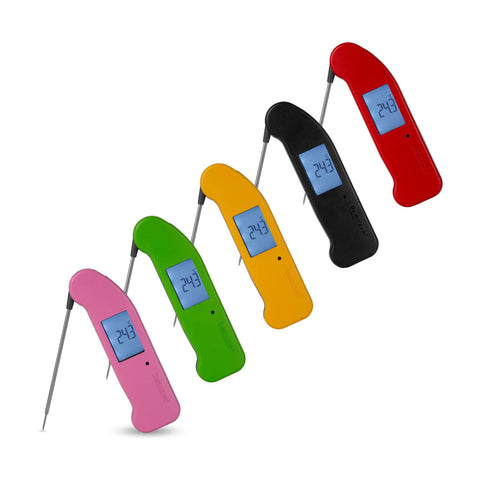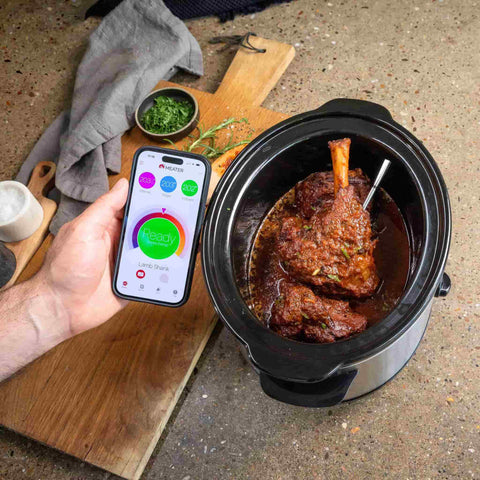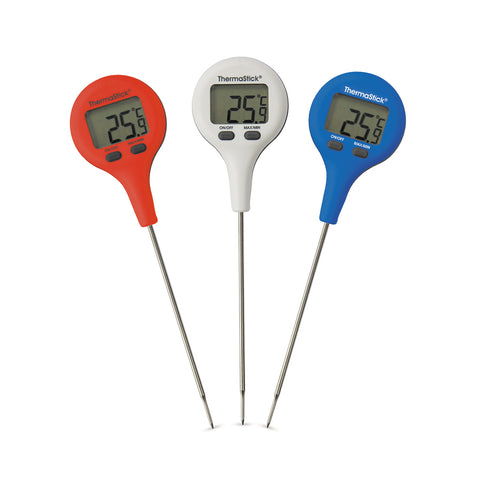Meat Cooking Temperatures: The Quick Guide
by Nicola Lando

Whether you’re cooking a Sunday roast for the family or inviting friends over for a barbecue, the most important aspect when making food is checking that the meat has been cooked at the right temperature.
Uncooked meat can result in illness, and the responsibility of serving food that is safe to eat falls on the chef. Yet also you don't want to end up with something tough and unappetising. The easiest way of cooking meat correctly is using a temperature device like a probe thermometer which will give a clear reading during the cooking process.
It's also important to understand the dangers of meat that hasn’t reached the right temperature, and get some advice on the right type of meat thermometer for your kitchen.
The temperature of your oven won’t tell you the temperature of the inside of your meat. Use a probe to tell if your meat is safe to eat.
Meat temperatures guide
This article covers...
- Optimal meat temperatures for cooking beef, lamb, chicken & pork
- How to use your probe thermometer
- Frequently asked questions about cooking temperatures for meat & fish
- Dangers of uncooked meat
- Top 5 meat thermometers you can buy
Optimal meat temperatures for cooking
The temperature of your oven won’t tell you the temperature of the inside of your meat.
Instead, it is the temperature inside your meat that will tell you how enjoyable the meat will be to eat. And importantly whether it is safe.
Here is a handy guide to internal meat cooking temperatures for beef, lamb, chicken and pork.
Once you know what temperature you're aiming for, read on down for more guidance on how to check internal temperatures with a probe thermometer.
Beef Temperature
- Rare: 125.6° Fahrenheit / 52° Celsius
- Medium Rare: 135° Fahrenheit / 57.2° Celsius
- Medium: 140° Fahrenheit / 60° Celsius
- Medium Well: 155° Fahrenheit / 68.3° Celsius
- Well Done: 159.8° Fahrenheit / 71° Celsius
- Ground Beef: 160° Fahrenheit / 71.1° Celsius
Lamb Temperature
- Medium Rare: 131° Fahrenheit / 55° Celsius
- Medium: 140° Fahrenheit / 60° Celsius
- Well Done: 159° Fahrenheit / 71° Celsius
- Ground Lamb: 160° Fahrenheit / 71.1° Celsius
Chicken Temperature
- 165.2° Fahrenheit / 74° Celsius
Pork Temperature
To cook pork perfectly: well done is 77°C and medium is 71°C.
- 160° Fahrenheit / 71° Celsius
Rare or Medium Beef and Lamb is Not Safe for Everybody
An internal temperature below 70°C for at least two minutes is not recommended for people with weakened immune systems (see details further down this article).
For more information on why these temperatures are optimal, see the guidelines from the Food Standards Agency here.
How to use your probe thermometer
When you're using a probe thermometer to check internal cooking temperature always make sure you're following the manufacturer's instructions for how to use it.
In addition, here are our three top tips:
- Start checking temperature with a probe thermometer towards the end of cooking - when the outside of the meat is already cooked (you don't want to move any uncooked nasties from the outside of the meat muscle to the inside, particularly if you plan to serve it rare).
- Always insert the probe into the thickest part of the meat, away from any bone, fat or gristle.
- Make sure you wash the temperature probe with hot soapy water before and after each use.
To choose your perfect meat thermometer browse the range here.
Frequently asked questions about cooking temperatures for meat & fish
Why can we eat raw fish but not raw meat?
While we might be happy to feast on sushi and sashimi all day long, the idea of raw chicken is enough to turn our stomachs.
So why is it ok to eat raw fish but not raw meat? Different animals contain different types of microbes and bacteria, and some are more harmful to humans than others.
When it comes to meat, the bacteria that live in and around livestock – which include listeria, E. Coli and salmonella - tend to be more dangerous to humans.
However, fish can contain parasites, so in the UK most fish intended to be eaten as raw as sushi or almost raw is required to be deep frozen before preparation.
If you want to eat raw fish, always get assurance from a good fishmonger that it is suitable. Generally fish should be cooked to 63°C.
Is rare beef safe to eat?
While most of us wouldn’t tuck into a half cooked pork chop, we’re more than happy to eat a medium-rare steak.
Why is this? Most harmful bacteria live in the animal’s guts (or could even be on knives, hands or surfaces where the meat is processed), while the inside of muscle is relatively sterile.
Therefore, beef is a good example of a meat that is by and large OK to eat rare. As long as there are no cuts in the meat, searing the surface of a steak will kill off that bacteria.
However, if you’re eating minced beef, it’s advised that you make sure it’s cooked through.
Minced beef is ground up meat and can also be a product of several animals, therefore even if a small section – usually from the outside of the muscle – is contaminated, it will spread quickly in the process of mincing.
Therefore burgers or minced beef should not be eaten pink or rare.

Why is uncooked chicken so dangerous?
Salmonella is commonly associated with uncooked chicken and is a bacterium that can live in chicken droppings, claws and on farm floors.
And it causes one of the most common intestinal infections amongst people in the United States, salmonellosis.
Campylobacter is a dangerous bacterium that lives in the stomachs of chickens and in and around the living environment of chicken farms.
This means that both bacteria can easily be found on flesh before the packing process.
Campylobacter is the most common cause of food poisoning in the UK, most of which comes from contaminated poultry.
Cooking chicken well kills these harmful bacteria.
Why don’t people tend to eat uncooked pork?
Historically pigs have been prone to a worm called trichinella spiralis, which is killed by cooking. Farmed pork in the UK is now thought to be free of the parasite, although that is not the case in all countries.
The UK Food Standards Agency still recommends a higher temperature for pork with the centre at 70°C for 2 minutes.
And most people still prefer that pork is cooked through completely.
However United States guidance now states that pork can be cooked to a minimum internal temperature of just 145°F or 63°C, and then left to rest for at least 3 minutes. That will leave it very slightly pink.

Dangers of uncooked meat
Not cooking meat properly can not only affect the taste, it can also increase the risk of food poisoning by bacteria including salmonella, listeria or E. coli.
Food poisoning can cause vomiting, sweats, diarrhoea and cramps.
Of course, the best way to kill these dangerous nasties in meat is to cook them thoroughly. Applying heat is the best way of destroying bacteria, parasites and microbes.
Top 5 meat thermometers you can buy
Not only can meat thermometers check that meat is cooked enough, it can also avoid overcooking so the taste isn’t ruined.
In short, if you’re doing any kind of cooking, a meat thermometer is essential kit.
This is our selection of the best meat thermometers you can buy:
Best for: Instant read internal temperatures
The Thermapen 4 has won rave reviews across the board.
It has a read-out of temperature over the range of -49.9 to 299.9 °C with a 0.1 °C resolution and an accuracy of ±0.4 °C.
You need never worry about taking a wrong reading, as the digital display auto rotates to give you the right reading whichever way you hold the device. Temperatures can be read in around three seconds.
The casing is washable and includes 'Biomaster' additive that reduces bacterial growth.
Best for: Reading internal temperature of a roast without opening your oven door
The MEATER 2 Plus is a wireless smart meat thermometer. It connects to your phone via bluetooth so you can monitor cooking temperatures. Slide the probe into the meat and the app will tell you when it’s done!
The MEATER 2 Plus can be used with a wide range of appliances. Use it in your oven, air fryer, barbecue and smoker. It’s also waterproof for deep frying and sous vide cooking.
The stainless steel probe can withstand direct heat up to 550°C. It’s ideal for grilling over an open flame.
Best for: Value! This is the entry-price point probe meat thermometer
With the ThermaStick meat thermometer in your pocket you can quickly and easily check the internal temperature of meat, cakes, and more. Simply turn on the probe, insert into the food to be measured, and in 5-6 seconds you’ll have an accurate temperature reading.
The ThermaStick has a large, easy-to-read display. After 10 minutes the thermometer will automatically turn off to save battery.
Best for: Checking the temperature of a BBQ before cooking
No contact needs to be made with this temperature checker.
Simply point and click – the infrared sensor will be able to pick up surface temperature.
The sensor has a 12:1 optic ratio (target distance: distance) and allows you to check the temperature of grills, stoves, pans and barbecues.
However, of course it won't tell you if your meat is cooked correctly.
Best for: Cooking multiple portions to different temperatures
This is the mega set of Meater probes - with at least four separate probes to check the temperature of different pieces of meat in different parts of the BBQ. Or to spot check temperature in different places of a very large joint of meat.
Happy barbecuing, roasting and frying! To see more tools to check meat temperatures, head here. Or if you prefer your meat raw... try our Korean steak tartare recipe.

About the author
Nicola is co-founder and CEO at Sous Chef. She has worked in food for over ten years.
Nicola first explored cooking as a career when training at Leiths, before spending the next decade in Finance. However... after a stage as a chef at a London Michelin-starred restaurant, Nicola saw the incredible ingredients available only to chefs. And wanted access to them herself. So Sous Chef was born.
Today, Nicola is ingredients buyer and a recipe writer at Sous Chef. She frequently travels internationally to food fairs, and to meet producers. Her cookbook library is vast, and her knowledge of the storecupboard is unrivalled. She tastes thousands of ingredients every year, to select only the best to stock at Sous Chef.
Nicola shares her knowledge of ingredients and writes recipes to showcase those products. Learning from Sous Chef's suppliers and her travels, Nicola writes many of the recipes on the Sous Chef website. Nicola's recipes are big on flavour, where the ingredients truly shine (although that's from someone who cooks for hours each day - so they're rarely tray-bakes!).







